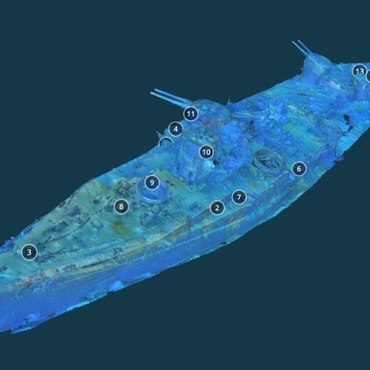
- Home
- A great scientific adventure
- Deep sea archaeology
- Wreck of the French battleship Danton (1909-17)
Discovered in 2008 to the south of Sardinia at a depth of 1,025 metres, the wreck of the battleship Danton was chosen to be the subject of an innovative archaeological operation.
Torpedoed
Built in Brest and launched in 1909, the Danton was 146 metres in length, 26 metres in the beam and carried a crew of 910 men. On 19 March 1917 she was holed by two torpedoes fired from the German U-boat U64 and sank in less than an hour, taking with her almost 300 seamen trapped in her 19,000 tons of steel.
This iconic event of the First World War was an ideal subject for archaeologists to research and popularize: the circumstances of the sinking, the exemplary behaviour of the crew under the leadership of post captain Joseph Delage who, along with his officers, refused to abandon ship, the conditions of the ship’s conservation, miraculously sitting upright on the seabed, and the quality of the archives held by France’s Ministry of Defence.
A digital construction set
Research carried out from 2009 to 2016, under the direction of Michel L’Hour (DRASSM), began in the archives before heading out to sea for two video and photographic surveys of the site. The result was a 3D reconstruction and virtual tour of the wreck founded on 42,000 images and 27 videos.
Operations at sea took place in 2015/16 and deployed, from the André Malraux, an ROV equipped with two floodlights of 250,000 lumens each which were specially built for DRASSM’s activities at extreme depths.
The 3D modelling of the Danton was developed as part of a cooperation programme involving DRASSM, the LIRMM, Ipso Facto and Dassault Systèmes 3D. It was supported by UNESCO.







